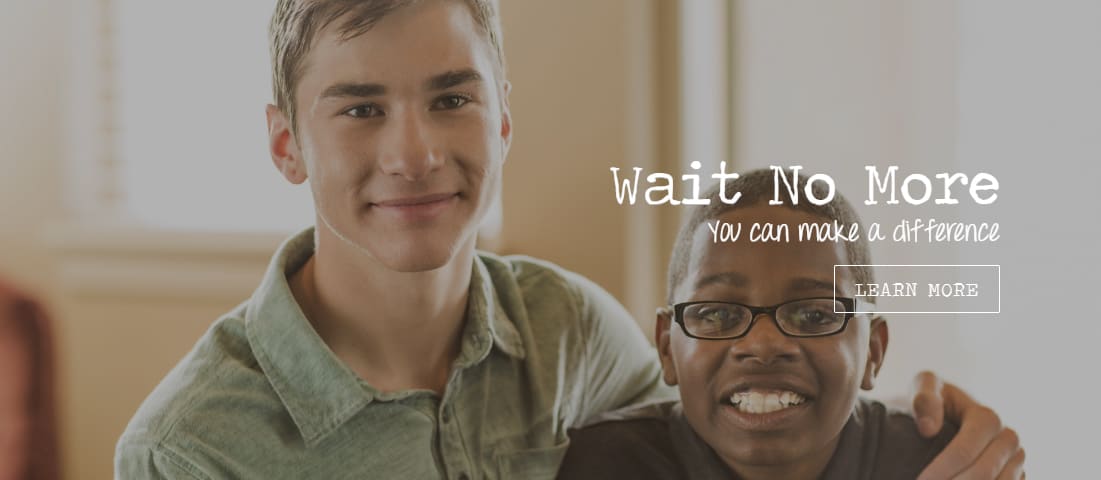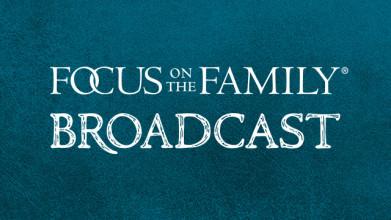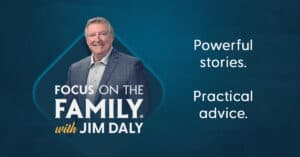Excerpt:
Mrs. Stacey Gagnon: I was afraid to do this. I was scared. I wasn’t special and God didn’t design me to be some incredibly special person that no one else has the abilities to do what I do. I was just obedient and stepped into it. And now I look at it and I’m like, oh, my gosh, I get to see this every day in my home. And it’s kind of like a high, it’s kind of like a euphoric feeling of like, oh, my gosh, God, look what You can do. Look what You can do in the life of this kid.
End of Excerpt
John Fuller: Well, that’s Stacey Gagnon describing her adventures as a foster and adoptive parent. And she’s here with us along with her husband, Darren, to share about their unusual family, which is going to inspire and encourage you today. Welcome to Focus on the Family. Your host is Focus president and author, Jim Daly. And I’m John Fuller.
Jim Daly: Well, November is National Adoption Month, and I am so glad that we can celebrate the courageous moms and dads that have said, yes, like Stacey and Darren, who have stepped into this special calling and helped rescue really children that don’t have families. And it’s a beautiful thing. Now, we know that not everyone can be a foster parent. Don’t feel a guilt trip. That’s not the – the goal of the program today. It’s more to just make you aware of the needs in foster care, adoption, et cetera, and then encourage you to ask the Lord what you might be able to do. It might be simply coming around an adoptive family and embracing them and helping them. There’s many ways to get involved and we’re going to cover those today.
John: Yeah, we, uh – there’s volunteering to babysit, running errands, a variety of things at our Wait No More website. We have a lot of different ideas about how you can come alongside, as Jim said, of foster or an adoptive family. And so, stop by the website. It’s focusonthefamily.com/broadcast. Or call 800, the letter A and the word FAMILY.
Jim: You know, I’ve mentioned this before, but when we started doing our Wait No More program here at Focus on the Family, which was to do exactly what I mentioned a moment ago, to help inspire, uh, people to consider working in the foster care area. I got home and Jean said, “Hey, if you’re going to ask others to do it, we need to do it.” (Laughter) And I was like…
John: It wasn’t what you were expecting, was it?
Jim: Yeah, it wasn’t. I was like, no, I was the foster kid. I don’t have to go through that again. But she was right. It was great to engage. And we became foster parents. We had both long term children and then short term stays where they just needed a place for a night or two. But it was so rewarding. And again, we’re going to cover this today. In the U.S. it’s called Wait No More. In Canada it’s called Waiting to Belong. And we are grateful for all of the families that have said yes and come to one of the events.
John: Yeah. These events are all designed to kind of enlighten, encourage, and inspire families to open their hearts and homes, to bring in a child through foster care. And it’s really made a difference in so many lives.
Jim: It has. And now let me officially welcome our guests, Darren and Stacey. Thank you for joining us today.
Stacey: We are delighted to be here.
Jim: I so appreciate it. Um, as I understand it, you’re both passionate advocates for orphans, and that’s great. And you have a heart for kids with special needs, particularly, which that’s special in itself, because that comes with a lot of additional requirements. And I really admire the fact that you’ve done that. But that wasn’t your original intent when you started your family, right? So, give us an idea about your family. How is it comprised?
Stacey: Well, um, actually, my original intent was no children. (Laughter)
Jim: Okay – no. You know what? A lot of women are in that spot. So, I appreciate the honesty.
Stacey: I was a college athlete, very driven, very career driven. And, um, I would say that starting out, I didn’t want kids. And then, you know, we laugh and say…
Jim: Can you – let me dig into that.
Stacey: Mm-hmm.
Jim: What was that motivating reason to not want children other than you were an athlete? And was it they were – would be a distraction or what – just sum that up for me.
Stacey: I think if I’m just summing is my – I was raised by a single mother. My father was an alcoholic. Um, and in my mind, I didn’t want to do that to a kid. I didn’t want to have a failing marriage…
Jim: Right.
Stacey: …Or have a child be raised by a single mom. And so, I think that in my mind, there were other things I could do. I wanted to work with kids, but I didn’t necessarily want to have my own to raise.
Jim: No, I appreciate that. And obviously, your testimony, your life, shows that God changed your heart in that regard.
Stacey: With a sense of humor, yes.
(LAUGHTER)
Stacey: God changed my heart in that. You know, so I think as we were looking at our family, then I conceded. Okay, let’s have two children. And we had a boy and a girl, and we were done. And so, at that point, I was teaching in the elementary school and a student came into my classroom who was new. And with any new student, you know, you set them by the student who is super driven and super organized. And so…
Jim: Is that why I always moved around?
Stacey: It was. Yes, it was!
(LAUGHTER)
Jim: Set Jim by the smart kid!
John: All these years!
Stacey: Exactly!
Jim: Now it makes sense to me!
Stacey: And so, um, I started teaching away and going about the day. And about halfway through the day, I looked back, and he is slumped over on his desk. And I hear him just ugly sobbing. And I’m like, oh, my gosh. And so, I walked back there, and I put my hand on his shoulder and I – I had him come right outside the classroom door and he just slumped down the side of the building and was sitting on – his head in his arms. And I kneeled down, and I and I said, “What – what’s going on, bud?” And he looked at me and I just remember his face, you know, just streaked with tears. And he said, “They took me from my home last night. I went to a foster home in this town and I don’t know the lady’s name I’m staying with and I don’t even know what bus to ride.” And…
Jim: Oh, my goodness.
Stacey: …I was just horrified that one of my students was living this. And so, I did a little more investigation and found out that in my community that they were having to stack children in homes because they didn’t have enough foster homes. And so, um, I went to Darren and just said, “You know, we need to do this. We can be a home for kids. We have extra room. And, you know, we can – we can do that.”
Jim: Yeah.
Stacey: And so, I guess the rest then is history.
Jim: And that child was 8, I believe. Is that right?
Stacey: Yeah.
Jim: Just to paint that picture. But…
Stacey: He was 8.
Jim: I’ll tell you, that is such a significant moment because I lived that, too. I mean, that loneliness and that unknowingness – that’s the best way to describe it. And when a teacher would put their hand on my shoulder and say, “Hey, do you need help?” It was an awesome thing, you know. It just reinforced the fact that somebody does care. Darren, you’re a teacher.
Mr. Darren Gagnon: Yep.
Jim: You – that’s what you have done. Uh, and that’s beautiful. You taught high school. Talk about you as the husband. So, you know, your wonderful wife is saying, “Hey, I’m feeling like this nudge.” Where were you at?
Darren: Sure. So, you know, I’ve always enjoyed working with kids all through college. I, uh – I taught middle school Sunday school – that age…
Jim: So, you’re one of those guys that said yes to middle school! (Laughter)
Darren: Yep. Yep. And it was always great. You know, I felt like in this situation, God kind of said, “Look, I’m going to open your eyes to – to a situation…”
Jim: Wow.
Darren: “…And then I’m gonna ask you to do something about it.” You know, I mean, we in America so many times, like, we – we’re aware of things, but we hesitate to get involved. Or, you know, it’s – life can be pretty complicated sometimes. And so, in this case, when Stacey told me what happened, I talked to some friends of ours that were a foster family, and we just decided, why not? If God’s calling us to do it, we should do it.
Jim: And we’re going to explore the why nots, because it’s not easy. Sometimes you’ll get a child that – you know, it can be easier, but these children come with a lot of emotional baggage. And I do want to uncover that as we move along. Let me ask you about backwards parenting. That’s an intriguing, I guess, approach. What are you getting at when it comes to backward parenting? Especially those kids that are coming from trauma – which many of these kids – I know, the 15 or so kids that we had through our home – some were little babies. You know, they were coming in because their mother was addicted to drugs and they’re trying to sort it out. Then others had other issues, whether it was abuse or something like that. But they come in with brokenness. I mean, that’s where you have to start. And it’s got to keep your anger or your overzealousness in check, right?
Stacey: Absolutely.
Jim: To start where they’re at.
Stacey: And I think so. We laugh because what I said earlier is, we thought love can fix this. I’m going to parent like I did my bio kids. And, you know, we subscribed to so many of Dobson’s books. You know, we love what we read – The Strong-Willed Child. We read all of the books because we wanted to be prepared. And I will tell you, yes, that with my – my trust based, my – my bio kids, that worked. But that kind of parenting does not work so much with the trauma child because their brain has been – the foundation of their brain is different. And so, backwards parenting is understanding that behavior is communication. And we believe that, right? And we say, “Yep, behavior is communication.” But for some reason, down the road we start – we kind of lose that. And so, when we’re parenting our kids and we see a scary behavior, we recognize that scared kids do scary things. And so, we are look – we are going to ignore the behavior and figure out what is the underlying need or fear that is not met right now. And it all goes back to attachment. It all goes back to that early foundational thing that’s happening. And so, when we are backwards parenting, it is not a free ticket out of consequences. It’s understanding I’m not going to play whack a mole with behaviors all day and not actually figure out why the behaviors are happening…
Jim: Well, which is the baiting that these kids typically do. Because I think in so many ways they want to basically say, “Do you love me even if?”
Stacey: Mm-hmm.
Jim: I mean, then you can fill in the blank. Do you have some examples so people can attach to what you’re saying? I mean, again, people that have compliant bio children, they’re like, “What is going on?” You know, it’s kind of like the person who’s never had children in the grocery store watching the kid have a frantic moment.
Stacey: Right.
Darren: Right.
Jim: And – and they say to themselves, “When I have children, they will never act like that.” Well, I don’t think that’s the case. (Laughter)
Stacey: Right.
Jim: You will soon find that not to be true. Uh, but give us an example of what you experience with these traumatized kids and how they continue to say, “Will you love me even if I…?”
Stacey: I – I like to use this story. It does not shine kindly on me. But it was when we first started fostering. We – we got two children in our home and, um, often is the case in foster care, you don’t know the history yet. You know, we were told that we were getting, um, a 4-and-a-half-year-old and a 2-year-old who didn’t speak English, they only spoke Spanish, which we find out later that they didn’t even speak Spanish. Um, they were pretty much speaking gibberish. But, um, I remember within the first week of being home – or in my home, I had made cupcakes for all of the kids. And I put them on the counter, and I had told all of them, like, “Hey, guys, we’re gonna have these after dinner. Don’t eat the cupcakes.” And I’m pretty sure right now your studio audience or whoever is laughing because I guess – I’m sure you guys can all guess what’s going to happen. I left the room to go do laundry because at my house there’s always laundry to do (laughter). And when I came back in the 4-and-a-half-year-old boy was standing there with cupcakes…
Jim: (Laughter).
Stacey: …In both hands, cupcake all over his face. And I in that – I just – I rounded the corner and I looked at him and I said, “Did you eat the cupcakes?” Well, I’m sure you can guess what he said, “No.”
Jim: (Laughter) Yeah. Right.
Stacey: No! And I’m looking at him and I’m like, “You’re holding the cupcakes in your hand.” And he is lie – he’s going to lie to me again. “No.”
Jim: Right.
Stacey: And he put some behind his back and he’s like, “No.” And he’s adamant that he didn’t eat the cupcakes. And I’m adamant that he’s holding the evidence in his hands. And so, in that moment, um, I realize that I was triggered by his lying…
Jim: (Laughter) Right.
Stacey: …And he was triggered with a survival brain telling him the worst thing that ever happened to me is about to happen again. And so, he was going to lie to survive. And had I known his internal narrative or his history, I would have understood that he, um, and his sister had been, um, locked in a room in an apartment with – with, um, no one around. No one even knew children lived in…
Jim: Yeah.
Stacey: …That apartment. Um, they had witnessed the murder of their infant brother.
Jim: Oh, my goodness.
Stacey: They had been without meals many, many times. And so, I didn’t know that. And I was going to punish a behavior instead of recognizing that he was a child that had food insecurity.
Jim: Right.
Stacey: And so, we learned very quickly. Wow, he had his own set of food. I mean, we nicknamed him Pop Tart because…
Jim: (Laughter).
Stacey: …He was addicted to Pop Tarts and he could have them whenever he wanted. So, we would just like, you know – I mean, he – we had boxes of Pop Tarts because that’s what he loved.
Jim: Yeah.
John: Hmm.
Stacey: And so, that’s a point of backwards parenting where we recognize that the behavior doesn’t matter. It’s what’s the underlying need that needs to be met?
Jim: That’s really good.
John: Hm. Yeah, this is really insightful and informative. And today on Focus on the Family we’re hearing about foster care and adoption and how some of these children can come from very hard places. And yet, God can work miracles in your home. Our guests are Darren and Stacey Gagnon and we’re so glad to have them here sharing their thoughts and their experiences. And if you’d like to learn more about foster care or adoption, let us support you in that. Our number is 800-A-FAMILY. Or stop by focusonthefamily.com/broadcast.
Jim: Darren, let me pull you in here because, you know, people are listening. We’ve had about 5,000 families start the adoption process through foster care, which is great. That doesn’t count the number that have wrapped around other adoptive parents, et cetera. We don’t know that number. But, um, you know, they’re energized by the discussion. They know what the Lord is calling them to. The book of James, talking about caring for the orphan. But, you know, there’s that apprehension. Describe that. And how to – how did the two of you get through that apprehension?
Darren: You know, Stacey and I over the years have talked about the, um – the idea of the American dream, right? And everybody talks about, you know, two and a half kids and a dog and a – you know, a nice home and…
Jim: White picket fence.
Darren: Yeah, exactly. And so, we decided once – we didn’t really set out to be foster parents. It kind of fell in our lap. We responded when we were kind of called to do it. But we kind of learned early on, like if – if you’re truly going to do what God asked you to do, the American dream has to kind of go, uh – go away and you start to live your life with purpose. And you so – so, you – you know, there’s a lot of fear involved. And I think that – I think especially for people who are looking from the outside in at fostering, you know, you hear all the horror stories of people who had bad experiences. But if you can get through that and you can go with faith and you can say, you know, “We’re going to do it even if even if things might go bad. We know this is what we kind of feel we’re called to do.” When Stacey and I were fostering, you know, the phone would ring and they would say, “Well, we have, uh, a child.” And, you know, most the time you’d ask lots of questions. You know, you’d want to know their age and lots of information about their background to decide if it was a good fit for your family. Well, after maybe six months of fostering and the phone kept ringing and we kind of didn’t know whether we should say yes or not. We just decided, you know, that doesn’t make any sense. If – if the phone rings, we’re just going to say yes…
Jim: Huh.
Darren: …Because we will know that God is already just decided we’re the ones that they’re going to call. They could call all kinds of different foster families, but they called us, so faith just leads us to say, (unintelligible) say yes. And I think – I think people just need to recognize that if they’re listening to what the Lord is calling them to do, just say yes and He will take care of the details.
Jim: Yeah. Now, in that context, you have the two bio children that you’ve talked about, but you had something like 30 foster kids come through your home and you adopted five of those, I believe. Is that accurate?
Stacey: So, we adopted three of them and then adopted two from orphanages in Eastern Europe. So, yes.
Jim: Okay. So, you know, quite a combination of needs and, you know, parenting needs, et cetera. But one of your sons named Joel is very special. Describe – they’re all special, obviously. But Joel had unique challenges. What – what was Joel story?
Stacey: So, Joel, um – we were done after four. So, we always laugh and say he was…
(LAUGHTER)
Jim: You keep having this negotiation with God.
Stacey: We were done.
John: Done after two, done after four.
Stacey: And then we were like, you know what? We have…
Jim: (Laughter).
Stacey: …We have room for one more. And we had just, you know, adopted our two middle children that had special needs and we’re like, you know, this is a niche. You know, everybody wants the baby, or everybody wants, you know, the child that’s neurotypical. And, you know, we – let’s give a home to a child that maybe would not get a home. And so, we said, “One more.” And so, at that point, we let our licensing worker know and she like goes, “Oh, my goodness, I know this kid. I saw him a year ago.” So, she tells me about this child in another town who has what’s called Goldenhar Syndrome. And Goldenhar is a craniofacial impairment or deformity, if you will. So, Joel has, um, facial disfigurement, so he’s missing an ear, part of the jaw in his face. And, um, he’s deaf and also has vision issues. And so, um, we were like, “Yeah” – just like Darren said, “Yes.” No, we just learned to just be obedient and say yes. And, um, we went to meet him, and it was just – I instantly knew, like, he’s – he’s number five.
Jim: Wow. The Lord just confirmed that in your heart.
Stacey: Mm-hmm. Yeah.
Jim: Now, I mean, that takes, um, some consideration. I agree with you, Darren, that as Christians that the yes. I love that.
Darren: Yeah.
Jim: That step of faith. But that can be intimidating to most people. And I understand that. It’s not a guilt thing.
Stacey: Mm-hmm.
Jim: How did you plow through that? I mean, just to say yes, because we trust God’s got a plan here and we need to be part of it. Is it that simple?
Stacey: I guess I would say yes, because nothing we do makes sense on paper, from finances to what our family makeup is, to all of the things that we do from day to day. None of it actually makes sense unless God’s involved in it. And so, um – and I also, if your listeners could hear this – disability is not a tragedy. God formed my children to be exactly who they were supposed to be. And the tragedy is the fact they didn’t stay with their bio parents. That’s a tragedy that they needed…
Jim: Yeah, that’s so true.
Stacey: …And I think when you are looking at kids, we all – and adults, too – we all have things that are special needs or extra needs within us. My children’s extra needs are just more external. And so, I don’t – I will tell you, if you met my kids, you would just be like, you are so lucky because we are. We’re so lucky.
Jim: Yeah, it’s beautiful. And, in fact, it led to you writing a children’s book with Joel about Joel, in a – in a way. But it’s called Cowboy Joel and the Wild Wild West. What happened with that? How did that idea come about?
Darren: You know, that was – it was a long process, but it was really fun to do. Um, you know, years ago when Joel was pretty young, he had a – kind of a bad experience. And – and, um, Stacy wrote a blog post that talked about how as parents we just need to be intentional about teaching kids that there are other kids who look different. And if we can kind of prepare them ahead of time, we might avoid some of the issues that Joel has. Because Joel looks different and so kids look at him and – and tend to stare. And it’s just a matter of, you know, misunderstanding most of the time. And so, when that had happened, we got contacted by NBC. We had him going on the Megan Kelly Show. We talked about – about how we can, you know, as parents do a little bit better. And then out of that, people said, “Well, how do we do it? How do we teach our kids about kids who look different if we don’t know any kids?” And so, we wrote a book.
Jim: Yeah, and that’s good. And in fact, that was born out of an experience where you took Joel to church and kids were kind of not very kind. They were looking, staring maybe. Is that a fair description?
Stacey: Yes. So, I had walked him back. We had gone to a new church because our oldest son was presenting there. And so, I had walked him back to the children’s ministry. And – and the reality is, I forget that he looks different, like we live in a small community. And you just – people are – you know, he goes to school with other kids. And so, we don’t see it or recognize it till we actually leave our town. And so, um, when we walked back into this children’s ministry building, every kid, when we walked in the door, stopped talking, started, um, whispering behind cupped hands and pointing at him. And he just, like, ran to the back of the room and put his head into his arm.
Jim: Yeah.
Stacey: And I’m like, oh. So, to me, it just – it – it just made me upset because I’m like, oh, my gosh, parents have got to teach their kids the correct way.
Jim: Yeah. A better way.
Stacey: A better way. Mm-hmm.
Jim: To teach, especially in that context.
Stacey: Right.
Jim: You know, I can only imagine Joel’s little heart.
John: Yeah, and so you blogged about that and got a little bit of reaction.
Stacey: Mm-hmm. Yes. So, it went – it went viral. And, um, you know, it just really became more of a conduit for us to be able to speak out about how to educate kids on children that have differences. So…
John: Mm-hmm.
Jim: Stacey, you’ve admitted, and I think very kindly, you know, you’re not a perfect mom. Guess what? There are no perfect moms…
John: Yeah.
Jim: … And there are no perfect dads. But we try hard and that’s the point. But I do want people because part, part of what we want to do is nudge people to consider how they can get involved, right? In that regard, what are the challenges that you face? And what did the Lord teach you about that being enough for your kids? Not perfect…
Stacey: Right.
Jim: …But being enough and kind of letting go of the laundry and all the stuff that make you feel imperfect because it’s not all done.
Stacey: You know, I – I look back on just, um, my life and especially in college. And shortly after I – I was very performance driven. I was a college athlete. I, um, excelled in academics and in sports. And I wanted to carry that over into motherhood. And, you know, with my two oldest, my biological children, I really was so driven to have a perfect home. My kids dressed perfect. My kids received all the things that I felt like made me a good mom and made us good parents to them. When we started fostering, I started drowning.
Jim: Yeah.
Stacey: I couldn’t maintain the perfection that I had for myself. And the reality is, like, I believe like foster care and adoption has saved me from – from a life of just performance for man. And these kids have like they honestly exposed some of my ugliest parts. And even in our marriage. But it’s been so beautiful because God has met me in those spaces and saying, like, “You’re enough because you’re showing up to love them every day.” And, you know, my kids are not in every sport. We – you know, we both were full-ride, college athletes. None of our children are athletic (laughter). And that’s good. You know, like when – they’re not in every sport. I don’t get to make every single production. I’m not able to keep up with laundry. You know, I am one of the worst cooks in the whole wide world.
Jim: (Laughter).
Stacey: Thank God I married someone that can cook. Like, and it’s okay because I’m enough as a mom in Christ teaching my kids about God’s love.
Jim: Well, it’s so beautiful because Jesus Himself was that example of getting involved in messiness. You know, the woman at the well, the woman caught adultery, the tax collector. I mean, He just kind of went where the righteous people didn’t go. And I think it’s a great example, you know, where He’s telling you, get involved in the mess.
Jim: Let’s end with the story about your son, Israel. And tell us about Israel, kind of describe him for us and then tell us how you taught him to become more independent by learning to get into a wheelchair. Because I think this is a great example of not falling prey to overdoing it, to make them so dependent.
Stacey: Right. Just to give you a little backstory on Israel, he – um, I was scared to death to bring Israel home. When I met Israel, he was 4-and-a-half, living tied to a crib in Eastern Europe. He had zero language as a 4-and-a-half-year-old. He, um, was on a liquid diet and was size of a 1-year-old. And so, when we brought Israel home – it did not mean it was easy because God had shown me that. I – I thought, I don’t want my son to be caged by me. And so, um, he started thriving in our home. It was amazing. He started talking. He started eating normal foods. He started getting around. And I recognized in him this desire to overcome. And as a mom, I had this incredible desire to protect because I know what he had lived for four and a half years. And so, it kind of all came to a culminating point, um, where he wanted to get into his wheelchair. And I told him, “Israel, you’re going to get in your wheelchair.” And he looked at me and he said, “Mommy, I can’t. It’s hard.” And I’m like, “You can do this.” And I walked out of the room (laughter) and I stood at the door and I watched him for 30 minutes trying and falling, trying and falling. And then came the moment where I just saw him do it. And he said, “Mommy, I did it.” And I think that that’s our goal in parenting our kids is just saying, “You know, it doesn’t matter your past. It doesn’t matter where you’ve come from. But you – you can be independent. You can do all these things because you’re loved, you’re safe and worthy.”
Jim: Wow. There’s so much in there that you’re talking about. I don’t care if you have bio kids, adopted kids. I mean, that is what the Lord – you can really sense, Stacey and Darren, how the Lord has shaped your heart and the things that you’ve learned through the process are beautiful. And, you know, I think for me, the kind of the last point and the thing that I’m so concerned about for the Church, certainly in North America – it may not be true globally, but the church in North America – we seem, um, so wrapped up in modernity that we’re failing to recognize God’s basic call to sacrifice, to love those around you. And you’ve demonstrated that in such a beautiful way. And we just need more people to say yes than to say, “Yes. Okay, I’m going to get messy. I’m not going to live for perfect. I’m going to live for imperfect, but good enough.” And such a beautiful story in this wonderful book, Cowboy Joel and the Wild Wild West. What a great expression to help kids understand how some people are different. And how do we interact with them and treat them. And just like the Lord’s heart, we do that with deep respect and love for that individual. Thank you so much for being with us today.
Stacey: Thanks for having us on.
Darren: Thanks. Yeah.
Jim: Hm.
John: And we’re going to encourage you to get a copy of this great book, Cowboy Joel and the Wild Wild West, for your child, for your grandkids, your church. Get copies of this book, spread it around, help children understand not everybody is made the same. And there is some joy in the other child that doesn’t look like you. Get a copy from us here at Focus on the Family. The website is focusonthefamily.com/broadcast. Or call 800, the letter A and the word FAMILY. And, uh, please send a gift of any amount to Focus on the Family. Join our support team and we’ll send a copy of the Gagnon’s book right out to you. That’s our way of saying thank you for supporting our efforts to wrap around foster care and adoptive families. On behalf of Jim Daly and the entire team, thanks for joining us today for Focus on the Family. I’m John Fuller, inviting you back as we once more help you and your family thrive in Christ.




















